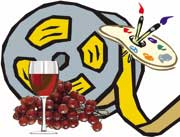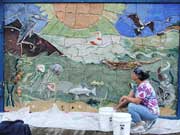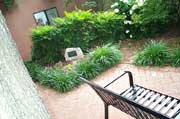
|
 Maryland Gives a Boost to State Art, Movies and Wineries Maryland Gives a Boost to State Art, Movies and Wineries
Amenity laws add to quality of life, promote state tourism
by Debra George Siedt
A wise person once said “A country that rejects art is on its way down.” This sage was no daVinci or Picasso; it was our very own comptroller, William Donald Schaefer.
During this spring’s legislative session, Schafer supported one of several bills to enhance Marylanders’ quality of life with an amenity he called vital to our survival. Financing for art in public buildings and support for state wineries and movie making all took center stage this year to help us live better — even in lean times.
“Some people don’t think [art] is important,” Schafer said. “But artistic things look good, and people remember that.”
Schaefer was introduced to the bill by an artist who goes to Baltimore’s Inner Harbor every week to wash her art and keep it clean. Mary Ann Mears, a Baltimore City artist, began to garner support for financing art in public buildings. After winning over Del. Maggie McIntosh, a Baltimore City representative, Mears also gained the support of Schaefer.
Mears “thought it would take her two years to pass a bill,” Schaefer said. “With her personality, she was able to pass it this year.”
To make public buildings look good, the General Assembly passed a bill devoting up to $1 million to finance artwork. The Maryland State Arts Council — part of the Department of Business and Economic Development — will decide what new art will be placed in buildings or what existing art will be restored. If the building is new, one-half of one percent of the building’s cost can be spent on art.
So, if a building costs approximately $10 million to build, $50,000 of public funding could be designated for artwork in it. The governor will need to designate funding for the bill; a commission is in the works and will be announced sometime before September.
While artwork for public enjoyment is not a new idea, public financing for it is. Last month, a new piece of art in Symphony Center Plaza, across from the Meyerhoff Symphony Hall in downtown Baltimore, was unveiled. The 50-foot tall sculpture, titled Firebird, was six years in the making. The $275,000 work was paid for by a developer of the Symphony Center buildings. Before this bill, public art was largely financed through private commissions.
“The arts in Maryland are not only an important economic generator, but also contribute significantly to an outstanding quality of life,” said Shareese DeLeaver, spokeswoman for the governor’s office. With Gov. Ehrlich up for reelection next year, his self-described “modest” agenda includes fewer controversial bills. Signing laws that support art for public buildings helps boost his public-friendly image.
“Public art is good and adds to the quality of life,” said Dennis Castleman, assistant secretary for tourism, film and the arts for for the state Department of Business and Economic Development. Ehrlich worked closely with the state’s economic development office on several other bills to enhance Marylanders’ quality of life through wineries and movie-making.
The number of wineries in Maryland is expected to almost double by 2008, from 16 to 30 vineyards. In the last year, four wineries opened, three to four are expected to open this year and another four to six next year. The Maryland Wineries Association is also depending on some newly passed legislation for a boost.
Last fall, Gov. Ehrlich established a task force to investigate how to help wineries and make Maryland more competitive with Virginia wineries. The 52-page report included a recommendation to hire a pathologist to support the industry and to establish a wine and grape promotion council. Both suggestions were passed by the General Assembly.
“From a tourism perspective, wineries are another product for visitors to want to come to Maryland,” Castleman said. “If there are great wineries, nice looking wineries, people will want to come.”
The industry says tourism is only the beginning of a long list of benefits enjoyed by wine-making states like California and Virginia. “Wineries promote land being preserved in long-term sustainable agriculture,” said Kevin Atticks, executive director of the Maryland Wineries Association. “Wineries and vineyards are good neighbors. They greatly increase property values and also foster the rural economies where many are located.”
In addition to funding a plant pathologist, who studies diseases, and establishing the council to disperse funds, the legislature also formalized the task force, now called the Governor’s Commission on the Maryland Wine and Grape Industry.
In addition to art and wine, 2005’s General Assembly has given Marylanders another luxury: fame. Several bills that passed will make it more attractive for studios to film their movies in Maryland. We’ll be seeing more of our state on the silver screen — and so will the rest of the world.
“Not only is it good for economic development, but when you shoot movies in Maryland, people see sights they know,” said Castleman. “It’s a feel-good thing.”
The film wage rebate credit, with a $4 million budget, gives movie studios more incentive to film in Maryland. The rebate gives a 50 percent return to the first $25,000 paid to each employee working on the production. The credit was such a success that the $4 million has already been spent for the upcoming fiscal year. Gov. Ehrlich pushed for the legislation after a movie titled Annapolis was shot in Pennsylvania, a state that offers incentives.
‘The movie industry generates $70 million in economic industry in the state each year,” said Castleman. “It creates jobs and creates an industry. We did not want to see that go away.”
The films that received the credit include a Walt Disney movie, Music High, which is shot in Baltimore. It’s a story about a young boy who gets in trouble with the law and is sentenced to clean a high school. While serving his sentence, boy meets girl who needs a dance partner. He finds out he has talent.
The other productions earning the credits are Rocket Science, an independent film, and the HBO production of Baltimorean David Simon’s The Wire, back for its fourth season, in part because of the incentive.
Castleman points to other movies that have been shot in the state, including Julia Roberts’ The Runaway Bride, the campy Blair Witch Project and The Wedding Crashers.
“Tourism affects the quality of life substantially,” Castleman said. “It really is great that you can invite friends and relatives to a state that has so much to offer.”
Enjoying a good work of art, sipping a bottle of Maryland wine and watching a movie set in a local neighborhood are amenities that would have never gotten approval from Annapolis’ Puritan founders. We’ve come a long way.
Debra George Siedt, a former teacher and reporter, is now a freelancing young mother living with husband and son in Shady Side. Her last story for Bay Weekly, “Buying Our First Boat,” appeared May 26
to top of page
 |
photo by Tammy Vitale
Artist Tammy Vitale grouts her ceramic mural along the boardwalk at North Beach. |
The Big Picture on the Boardwalk
New North Beach mural introduces neighbors who swim and fly
by Sara Ebenreck Leeland
As Calvert County artist Tammy Vitale added finishing touches to her new Chesapeake Bay mural, she found that a picture is worth 1,000 questions.
Child: Is it OK to touch the seahorses?
Vitale: Yes, I like it when you touch it. It’s made to be touched.
Elder woman: What fish is that?
Vitale: A rockfish. I created the mold directly from a Bay rockfish.
Younger woman: How did you get the idea for this?
Vitale: When I came here to Southern Maryland, I fell in love with the land and water. This mural expresses why I came here.
It’s hard to miss this addition to the boardwalk at North Beach, where people come for miles to get into sand, sun and water at one of Chesapeake Country’s rare public beaches. Seven and a half feet tall by 10 feet wide, the mural covers the front of a building.
It’s not only on the Bay but also about the Bay. Near the top, a huge sun sends its energy out over the tile. A blue heron dominates the left side, and an osprey wings down from the sky in the upper right. But three-quarters of the mural is water. Oysters and sea squirts lie on the bottom. An otter, blue crabs, seahorses, sea grasses and waves lift up toward the sun.
“The sun gives the energy for all life. The lines of movement are designed to keep the viewer in the picture,” explains Vitale.
Making these images took physical work as well as artistry. Delivered to Vitale’s home studio were 900 pounds of clay, enough to build an eight-inch layer of clay the rough size of the mural.
To manage manipulating that much clay, Vitale divided the mural into six rectangles while her son Jon built tables to hold the pieces. The tables could be put together to assure that all the lines of each connected to their neighbors.
“The work activated every muscle in my body: hands, elbows, shoulders and hips,” Vitale said.
From the clay, she sculpted her images into tiles. When tiles are fired, they shrink. The exact color that emerges from the fire “is ruled by the kiln god,” Vitale said. So getting the pieces just right took a fair amount of experimentation.
Those are the kinds of challenges the artist anticipated when North Beach mayor Mark Frazier commissioned her after seeing her work in the gallery ArtWorks at 7th Street, including a seven-by-seven-foot heron and a two-by-four-foot mermaid.
“We need to remember that we are a part of this interconnected Chesapeake creation. The blessing of time here by the water is partly that it draws us out of clock-time and into natural rhythms.”
Sara Ebenreck Leeland left Bay Country for a new home in Michigan, but much of her writing remains moored in the Chesapeake. Her stories appeared regularly in Bay Weekly in 2003 and 2004.
to top of page
 |
| photo courtesy of City of Annapolis |
Oases in the City
Pocket parks offer relief from urban congestion
by Carrie Steele
Crowds of buildings line a grid of streets amid bustling downtown Annapolis. Brick, concrete, wood and asphalt define the city’s parameters.
But turn a corner and you find yourself in — ahh — a tiny, pocket-sized park. Not more than a few paces wide or a stone’s throw long, these little landscapes amid the cityscape offer a breath of fresh air to natives and tourists alike.
Most recently finished are the parenthetical pathways around Hillman Garage, near City Hall, which connect Duke of Gloucester to Main Street .
This parcel near Hillman Garage and the old Hopkins Furniture building was turned from urban alleyway to garden passageway at the urging of Mayor Ellen Moyer.
“When she came to be elected mayor it looked ratsy,” said city spokeswoman Jan Hardesty. “The mayor said, ‘we’ve got to do something about this.’ She pushed the people who are management of the garage. It was also the responsibility of the owners of the Hopkins building, who financed the pocket park, because it was contiguous to them,” said Hardesty.
Digging the garden, they even hit a natural spring.
“You can hear the water gurgling when you go down there,” said Hardesty, who suggests a fountain at the spot one day.
The garden lining the garage entrance off Duke of Gloucester — dedicated to past first ladies of Annapolis, the wives of mayors — boasts colorful petunias among other foliage. Walk to the left, and butterfly plants and roses usher you down the pathway to the front of the garage.
Neighbors have pitched in to help plant and care for the gardens on both sides of the garage.
 |
photo by Carrie Steele
Digging the narrow pocket garden beside Annapolis’ Hillman Garage, left, workers uncovered a natural spring. Benches and flowers beckon passers-by at the Fleet Street pocket park, above. |
Around the other side, to the right off of Duke of Gloucester, paths diverge around a strip of river rock, which directs runoff into a storm drain. Trees — and surrounding buildings — shade this dappled pocket park. So Norman Alton of Greensleeves, landscaper of the pocket park, filled it with shade-loving hosta, nandina and butterfly-attractants. Vinca helps control erosion, as shrubs and greenery soften the concrete walls on either side.
There’s even thistle — as on Annapolis’s crest — sewn among the garden plants.
Pocket parks yield room for art, too.
A mural painted by Stewart White depicts life by the Bay, with sails, birds, docks and watermen. On one side of the mural, White quotes Mark Twain: We must sail with the wind, and sometimes against it, but we must sail, and not drift nor lie anchor.
As more once-abandoned spaces — often alleys or shortcuts — give way to green oases, taking the scenic route may not necessarily mean a longer walk.
You’ll find refreshment in other city pocket parks, as well. Just half a block behind City Dock, Fleet Street Park is tucked just off the asphalt road between two houses, In this tiny pocket, benches invite you to linger under a leafy shade tree, while hydrangea and shrubbery, as well as flowers, offer respite from the busyness just steps away.
Newly planted Newman Street Park — across from the Fleet Reserve Club and across the parking lot from Annapolis Summer Garden Theater — turned an urban corner, with cracking asphalt and worn, wooden benches, into a clean-cut sitting area with a low wall and rain gardens. Financed by the City of Annapolis, Project Open Space and Annapolis Rotary, it’s now an updated playground, basketball court and sitting area with landscaping right there for City Dock visitors.
These three oases are part of a growing trend to use every bit of Annapolis’ downtown space. Look closely to find such pocket-sized parks in nooks and crannies hiding in and around urban Chesapeake Country.
to top of page
|






